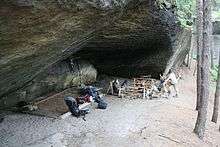Czech tramping
Tramping (in Czech and Slovak language) is a movement incorporating woodcraft, hiking/backpacking/camping and scouting, with a characteristic flavour of and styled on American culture, especially the Wild West.[1] The latter is particularly noticeable in the tramping song, a song and musical style associated with tramping.
Tramping originated in Czechoslovakia in the beginning of the 20th century[1] and is still present in today's Czech Republic and to a lesser degree in Slovakia. It manifests itself in a distinctive style of clothing, hiking culture and tramping music. For the urban youth it was a specific form of a "return to nature".

History
Czech interest in 'Amerika' dates back to the nineteenth century, when Bohemia and Moravia (and most of Central Europe) were provinces of the Austrian Empire. Writings about the United States to Czechs through journalistic and monographic reports by Jan Náprstek and others highlighted to exotic degrees the natural and cultural richness of 'Amerika' (to use the word that Franz Kafka, who was from Prague, used as the title of his 1927 novel). The first community of Czech "tramps" arose probably in 1918. Having been an original Czech movement, tramping became popular in Slovakia in 1925-1928
The introduction of the worldwide scouting movement to the region roughly coincided with the beginnings of the popularity of the 'western' novelist Karl May, a German, and the formation of the first Czechoslovak Republic. The economic successes of the new nation and its many political and social links to the United States (for example the first Czechoslovak President, Tomáš Masaryk, was married to Charlotte Garrigue, who was from a prominent American family and part of the reason for Masaryk's success in persuading Woodrow Wilson to support the inception of Czechoslovakia) meant that Czechs' interest in things American continued in earnest. Films starring Tom Mix and the 'modernistic' strains of the latest foxtrots and tangos were some of the many cultural imports.
Tramping, not to be confused with simple hiking, is a pastime born out of the pressures and opportunities of the interwar period. Saturated with idyllic images of the American West and seeking respite from the pressures of modern urban life, many Czechs set off into the woods. Tramp settlements with names such as Hudson, Little Bighorn and Swanee soon became temporary homes for scores of Czechs impersonating cowboys, Red Indians, forty-niners and other American characters.
What began as a weekend pastime gained importance during World War II, when forays into the woods became illegal, though many found them culturally and socially important. American musical expressions such as those that had enlivened interwar tramps' campfire gatherings became more politically potent as well as more uniquely Czech. After the 1948 Communist takeover, tramping's rebellious streak continued and represented a phenomenon of an attractive alternative culture(an "internal emigration").
The sort of American-type music that thrived as part of this movement was never seriously repressed. The sentimental nature of much of the repertory of tramping songs made them much less objectionable than rock and roll and jazz.
The golden age of this movement was in the period of 1930-1990 when the amount of "tramps" in Czechoslovakia reached 40,000 - 80,000 people. (In a case of non-organized individualistic movement any guess is always speculative.) The Czech and Slovak tramps established several thousand provisional settlements ("osada") - mostly around big cities (Prague, Bratislava, Plzeň, Ostrava, Brno)- with elements of a specific architecture (wooden cabins, fireplaces, totems etc.) imitating the Wild West.
See also
- Tramp
- Hiking
- Backpacking (hiking)
- Lifestyle travelling
- Wandervogel movement
References
- "Protektorátní školák a jeho volný čas" ("A Student in the Protectorate and His Free Time")